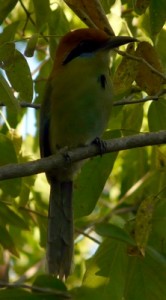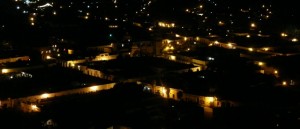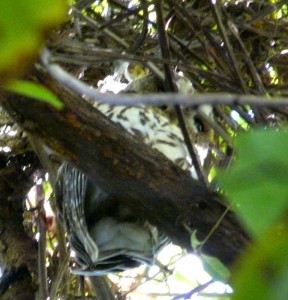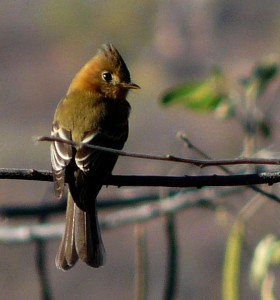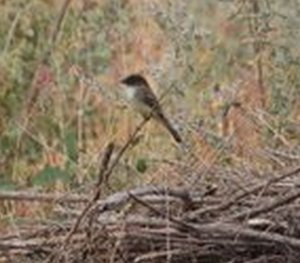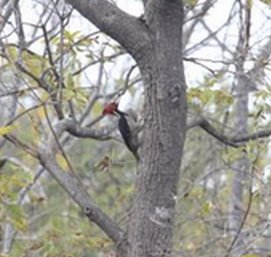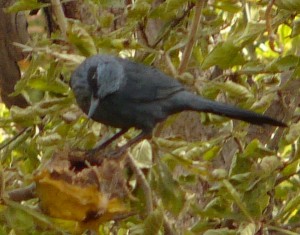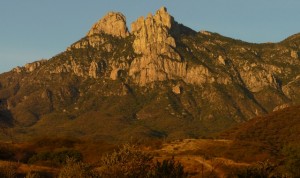 January 2nd was a big day. The largest number of participants in the history of the Alamos CBC headed off to their individual areas and started looking for and counting birds. It was a lot to put together in a way, but it all went off nearly without a hitch, and the compiler (me) was no where even close to the circle center to make sure everyone got to where they needed to be. I'm sure that this was a bad thing! Thanks to everyone who figured out any last minute logistical errors that I may have left behind! I want to thank everyone for helping to make it all come together so well!
It looks like the total number of participants ended up being 38, exactly twice as many as the previous high number of participants. This alone made me very happy and certainly made the possibility of breaking the old count record of 169 far more possible that it had been in previous years!
Compiling a CBC is always a hard job. There are personalities, personal schedules, abilities, desires and lots of logistics to
January 2nd was a big day. The largest number of participants in the history of the Alamos CBC headed off to their individual areas and started looking for and counting birds. It was a lot to put together in a way, but it all went off nearly without a hitch, and the compiler (me) was no where even close to the circle center to make sure everyone got to where they needed to be. I'm sure that this was a bad thing! Thanks to everyone who figured out any last minute logistical errors that I may have left behind! I want to thank everyone for helping to make it all come together so well!
It looks like the total number of participants ended up being 38, exactly twice as many as the previous high number of participants. This alone made me very happy and certainly made the possibility of breaking the old count record of 169 far more possible that it had been in previous years!
Compiling a CBC is always a hard job. There are personalities, personal schedules, abilities, desires and lots of logistics to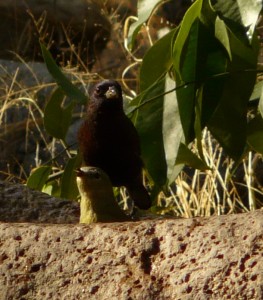 consider. In the case of a count that has an international destination, you can add in the language barrier and transportation issues! Mostly, I enjoyed organizing the count and it was only towards the end when I got a bit tired of people's personal problems and how they might influence others and the count in general! I do believe, much like my buddyAdam, who compiles the Navopatia count, that CBC's are suppose to be fun and I do really want people that participate to work an area that they will enjoy and get something out of the whole thing. Sometimes this is difficult to pull off when you get more novice birders or folks that want to participate but don't know an area or the birds that they might see. It is crucial that as much accuracy as possible is maintained, and sometimes this is only achieved by sending some people to places that might not be the most beautiful or interesting from first look. The important thing for participants to remember is that they are covering ground that may turn up the most interesting bird of the count, and often that bird is found in one of the most unsavory of locations. This is not a Saturday morning birding trip with friends, this is an attempt to really propagate a chain of data and ultimately the count circle is what is important.
This years count started out with 6 solid teams, made up of birders from both sides of the border and an extreme variety of abilities. We were fortunate to have an abundance of local Mexican talent that has bloomed from the Sonoran Joint Venture bird guide training program and a number of great birders from the US who were super excited to look at some new birds! We were also fortunate to have the support of a number of Alamos seasonal foreign residents who were willing to donate their vehicles and time to help us get folks in and out of the field.
I think that it is important to acknowledge the efforts put out by all of the people that participate and compile CBCs all over the world. There is a huge amount of time and expense put out by a lot of people to make these counts a reality. For this count we had participants that traveled by bus for 24 hours, buy gasoline to transport people to the far ends of the count circle, sacrifice the longevity of their cars to shuttle people to far flung locations on "roads" not fit for vehicles, buy beer when there was none, and help fight off disorganization!
The other side of the coin is that it is a heck of a lot of fun! It 's hard for me to express the good feeling that I had at the compilation dinner that night at the Mirador. There we were having a few beers, eating a fantastic Mexican feast with old and new friends, Mexican and American, of all ages and walks of life... it was a great experience. Not to mention that we broke the old species record and covered more of the circle than had ever been done before. I was proud and thinking about how to make it even better for next year.
The first team organized and left El Pedregal at 3:30am. That team was made up of myself and Mario Ibarra. I had been goading Mario to do the mountain and its high elevation portion of the count for several weeks and he never said that he didn't want to do it, in fact he was excited to go up there. I was happy to have him, as the past several years I had been covering the upper elevations alone, because no one ever seems that excited to get up that early and hike 15 miles and do over 4500 feet of elevation gain!
So, off we went in my 1974 Chevy truck to the village of Uvalama and the trail head that would take us up. At the last minute, I threw in a couple of flashlights...more as an after thought than anything else. Thank god the batteries were good, because we used them solidly for the first 3 hours that we were on the trail! I had neglected to take into account that it was the new moon and it was REALLY DARK on the trail! Indeed, when we got to the big arroyo crossing that would take us to "La Huerta", I got totally lost even with the light! Mario and I stumbled around for about 45 minutes looking for the trail that should have been just on the other side, but never did find it. I was worried that we would end up loosing a lot of birding time, so I opted for turning around and heading back down the trail to look for an alternate route that bypassed the arroyo completely. Well it
took us a while just to refind the trail that we had come into the arroyo on, and once we did, we walked passed the trail that we intended to find! A total mess that ended up costing us a good hour and half of birding time. I think Mario was wondering just what kind of mountain guide I really was! The up-side was that we did end up hearing a Mottled Owl, Colima Pygmy Owl and a Western Screech Owl calling down the canyon below us, these were three of the four owl species found on the count!
At this point, it had gotten light enough for us to put away the flash lights and concentrate on getting into pine-oak habitat. I was intent on proving the old adage that a little bit of knowledge is dangerous! After kicking ass to get up to the pines, we came across a good trial heading off to the west that I had never seen before, chances were that it was a clandestine agriculture route, but I had heard of a trail that cut short the trip to the summit of the mountain and this sure looked like it was going in the right direction. So off we went and soon after we were crossing a fence and entering absolutely great habitat that had not seen cows in a long time. The birding was slower than I expected it to be, probably due to the high overcast and a bit of wind and I was worried that the other teams might be having the same problem. As I predicted, the trail did turn out to be a clandestine agriculture route and ended at a pile of cleaned marijuana stalks on a little hill with a beautiful view of the valley below. There was another trail that continued on down into a side canyon, but that just looked like trouble to me, beside we where trying to go up, not down!
By this time all of the other teams would have assembled and were off to their locations.
It was refreshing going up the mountain with Mario. I often take for granted how comfortable I feel just taking off up a 5,000 foot mountain with no real official trail in the out back of Mexico. Sure I might be a bit crazy, but I know the rewards of doing it and the adventure quotient is high! Hiking and adventuring have pretty much been a part of my life since I was a little kid. Mario has lived in Alamos all his life and I bet no one in his family has ever hiked to the top of Alamos mountain or any mountain for that matter, or maybe even thought about doing it. So when he said that he wanted to go with me, it made me really want to take him all the way to the top, not that it is the best part of the mountain, but it is the top! So, all that morning I was thinking that our goal would be the summit, but when it became evident that this was not going to happen, I have to say that both Mario and I felt a sense of relief! Mario did great the entire hike and never let on that he was tired or ready to slow down. Because of this I think I thought that this young guy was trying to kick my ass so I actually went faster than I normally would have and I got tired as hell!
We did end up making a short diversion to a place that they call "Mesa de Don Miguel". I have no idea why it is called that. The best reason to go there is to get the big view of Alamos and the Sierra Madre. Mario and I spent a little time taking in the view and eating a bit of lunch.
As we hit the upper La Huerta on the way down, I started playing more Colima Pygmy Owl and things seemed to be picking up as the sun finally warmed things up in that north facing canyon. Well, it paid off big time. I was concentrating on all the warblers that were coming in when I heard the high pitched whistle that I knew was a Orange-billed Nightingale-Thrush. Sure enough with only a bit of work the bird came in and we got great looks at it, a new bird for Mario! That would have been all we needed, but just as the thrush danced in, another bird waltzed out on to the same downed log. A Rusty-crowned Ground-Sparrow, a bird that is certainly at its northern limit and not a regular on the Alamos count by any means! I was ecstatic and it was another new bird for Mario!
consider. In the case of a count that has an international destination, you can add in the language barrier and transportation issues! Mostly, I enjoyed organizing the count and it was only towards the end when I got a bit tired of people's personal problems and how they might influence others and the count in general! I do believe, much like my buddyAdam, who compiles the Navopatia count, that CBC's are suppose to be fun and I do really want people that participate to work an area that they will enjoy and get something out of the whole thing. Sometimes this is difficult to pull off when you get more novice birders or folks that want to participate but don't know an area or the birds that they might see. It is crucial that as much accuracy as possible is maintained, and sometimes this is only achieved by sending some people to places that might not be the most beautiful or interesting from first look. The important thing for participants to remember is that they are covering ground that may turn up the most interesting bird of the count, and often that bird is found in one of the most unsavory of locations. This is not a Saturday morning birding trip with friends, this is an attempt to really propagate a chain of data and ultimately the count circle is what is important.
This years count started out with 6 solid teams, made up of birders from both sides of the border and an extreme variety of abilities. We were fortunate to have an abundance of local Mexican talent that has bloomed from the Sonoran Joint Venture bird guide training program and a number of great birders from the US who were super excited to look at some new birds! We were also fortunate to have the support of a number of Alamos seasonal foreign residents who were willing to donate their vehicles and time to help us get folks in and out of the field.
I think that it is important to acknowledge the efforts put out by all of the people that participate and compile CBCs all over the world. There is a huge amount of time and expense put out by a lot of people to make these counts a reality. For this count we had participants that traveled by bus for 24 hours, buy gasoline to transport people to the far ends of the count circle, sacrifice the longevity of their cars to shuttle people to far flung locations on "roads" not fit for vehicles, buy beer when there was none, and help fight off disorganization!
The other side of the coin is that it is a heck of a lot of fun! It 's hard for me to express the good feeling that I had at the compilation dinner that night at the Mirador. There we were having a few beers, eating a fantastic Mexican feast with old and new friends, Mexican and American, of all ages and walks of life... it was a great experience. Not to mention that we broke the old species record and covered more of the circle than had ever been done before. I was proud and thinking about how to make it even better for next year.
The first team organized and left El Pedregal at 3:30am. That team was made up of myself and Mario Ibarra. I had been goading Mario to do the mountain and its high elevation portion of the count for several weeks and he never said that he didn't want to do it, in fact he was excited to go up there. I was happy to have him, as the past several years I had been covering the upper elevations alone, because no one ever seems that excited to get up that early and hike 15 miles and do over 4500 feet of elevation gain!
So, off we went in my 1974 Chevy truck to the village of Uvalama and the trail head that would take us up. At the last minute, I threw in a couple of flashlights...more as an after thought than anything else. Thank god the batteries were good, because we used them solidly for the first 3 hours that we were on the trail! I had neglected to take into account that it was the new moon and it was REALLY DARK on the trail! Indeed, when we got to the big arroyo crossing that would take us to "La Huerta", I got totally lost even with the light! Mario and I stumbled around for about 45 minutes looking for the trail that should have been just on the other side, but never did find it. I was worried that we would end up loosing a lot of birding time, so I opted for turning around and heading back down the trail to look for an alternate route that bypassed the arroyo completely. Well it
took us a while just to refind the trail that we had come into the arroyo on, and once we did, we walked passed the trail that we intended to find! A total mess that ended up costing us a good hour and half of birding time. I think Mario was wondering just what kind of mountain guide I really was! The up-side was that we did end up hearing a Mottled Owl, Colima Pygmy Owl and a Western Screech Owl calling down the canyon below us, these were three of the four owl species found on the count!
At this point, it had gotten light enough for us to put away the flash lights and concentrate on getting into pine-oak habitat. I was intent on proving the old adage that a little bit of knowledge is dangerous! After kicking ass to get up to the pines, we came across a good trial heading off to the west that I had never seen before, chances were that it was a clandestine agriculture route, but I had heard of a trail that cut short the trip to the summit of the mountain and this sure looked like it was going in the right direction. So off we went and soon after we were crossing a fence and entering absolutely great habitat that had not seen cows in a long time. The birding was slower than I expected it to be, probably due to the high overcast and a bit of wind and I was worried that the other teams might be having the same problem. As I predicted, the trail did turn out to be a clandestine agriculture route and ended at a pile of cleaned marijuana stalks on a little hill with a beautiful view of the valley below. There was another trail that continued on down into a side canyon, but that just looked like trouble to me, beside we where trying to go up, not down!
By this time all of the other teams would have assembled and were off to their locations.
It was refreshing going up the mountain with Mario. I often take for granted how comfortable I feel just taking off up a 5,000 foot mountain with no real official trail in the out back of Mexico. Sure I might be a bit crazy, but I know the rewards of doing it and the adventure quotient is high! Hiking and adventuring have pretty much been a part of my life since I was a little kid. Mario has lived in Alamos all his life and I bet no one in his family has ever hiked to the top of Alamos mountain or any mountain for that matter, or maybe even thought about doing it. So when he said that he wanted to go with me, it made me really want to take him all the way to the top, not that it is the best part of the mountain, but it is the top! So, all that morning I was thinking that our goal would be the summit, but when it became evident that this was not going to happen, I have to say that both Mario and I felt a sense of relief! Mario did great the entire hike and never let on that he was tired or ready to slow down. Because of this I think I thought that this young guy was trying to kick my ass so I actually went faster than I normally would have and I got tired as hell!
We did end up making a short diversion to a place that they call "Mesa de Don Miguel". I have no idea why it is called that. The best reason to go there is to get the big view of Alamos and the Sierra Madre. Mario and I spent a little time taking in the view and eating a bit of lunch.
As we hit the upper La Huerta on the way down, I started playing more Colima Pygmy Owl and things seemed to be picking up as the sun finally warmed things up in that north facing canyon. Well, it paid off big time. I was concentrating on all the warblers that were coming in when I heard the high pitched whistle that I knew was a Orange-billed Nightingale-Thrush. Sure enough with only a bit of work the bird came in and we got great looks at it, a new bird for Mario! That would have been all we needed, but just as the thrush danced in, another bird waltzed out on to the same downed log. A Rusty-crowned Ground-Sparrow, a bird that is certainly at its northern limit and not a regular on the Alamos count by any means! I was ecstatic and it was another new bird for Mario!
Armando Mejia led a small group up to Rancho Sierrita on the east facing slope of
the Sierra de Alamos, and spent the entire day hiking in good tropical deciduous forest habitat. Along the way they found Ivory-billed Woodcreeper and two new birds for the count, an Eastern Phoebe and a Pale-billed Woodpecker! The phoebe was a big surprised considering that it was no where near any water but the woodpecker was bound to be on the count eventually as a few had been seen over the past few years just to the south of this area. The two birds observed were interacting with two Lineated Woodpeckers.
The upper Mentidero group ran into a Grasshopper Sparrow which is not common for the count.
Rafa walked Bucho Martinez's ranch and found a number of species that were not seen anywhere else, including several species of ducks and the only Least Grebes of the day.
We ended the count with 172 species on count day and added another 4 for the week to make 176. 172 broke the previous record of
169. There were four new birds added to the Alamos list. Pale-billed Woodpecker, Eastern Phoebe, Bushtit and Euraisan Collared-dove.
The compilation dinner was hosted by our friend Herkulano who runs the Mirador Restaurant up on the hill above town. He has the best Mexican food in town, if you ask me, and has been a great asset when it comes to taking care of our birding groups over the years. His maximum capacity was basically the number of participants that we had so he was a bit worried when I told him that we might actually go over 40 people. In the end it was perfect. The buffet included Barbacoa (a traditional Sonoran dinner that is best described as beef stew), Tomatillo Enchiladas, Tacos Dorados, Chili Rellenos, Beans, Rice and a huge bowl of salad. We brought up a couple of coolers of beer as he has no license to sell alcohol but is happy let us bring it in.
I know it how big of a commitment it is for people to come all the way to Alamos to help count birds, our hope is that everyone has a great time, gets to see some new birds and tells all their friends to come with them next year!
For Matt Brooks Tucson Audubon blog post on the Sonora CBC's click here http://tucsonaudubon.blogspot.com/
If you would like to see the final report, follow the instructions below
- go to http://birds.audubon.org/christmas-bird-count
- In the right-hand column, click on “Results: Current Year” in the right-hand column
- Under Option C, enter the count code: MXAL
- Follow instructions to “Make a Table”
